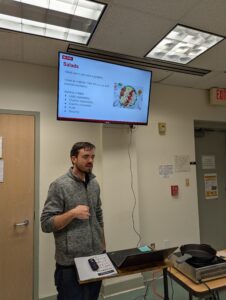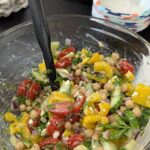Avoid Boring Salads
go.ncsu.edu/readext?1067596
en Español / em Português
El inglés es el idioma de control de esta página. En la medida en que haya algún conflicto entre la traducción al inglés y la traducción, el inglés prevalece.
Al hacer clic en el enlace de traducción se activa un servicio de traducción gratuito para convertir la página al español. Al igual que con cualquier traducción por Internet, la conversión no es sensible al contexto y puede que no traduzca el texto en su significado original. NC State Extension no garantiza la exactitud del texto traducido. Por favor, tenga en cuenta que algunas aplicaciones y/o servicios pueden no funcionar como se espera cuando se traducen.
Português
Inglês é o idioma de controle desta página. Na medida que haja algum conflito entre o texto original em Inglês e a tradução, o Inglês prevalece.
Ao clicar no link de tradução, um serviço gratuito de tradução será ativado para converter a página para o Português. Como em qualquer tradução pela internet, a conversão não é sensivel ao contexto e pode não ocorrer a tradução para o significado orginal. O serviço de Extensão da Carolina do Norte (NC State Extension) não garante a exatidão do texto traduzido. Por favor, observe que algumas funções ou serviços podem não funcionar como esperado após a tradução.
English
English is the controlling language of this page. To the extent there is any conflict between the English text and the translation, English controls.
Clicking on the translation link activates a free translation service to convert the page to Spanish. As with any Internet translation, the conversion is not context-sensitive and may not translate the text to its original meaning. NC State Extension does not guarantee the accuracy of the translated text. Please note that some applications and/or services may not function as expected when translated.
Collapse ▲We all know we should be eating more fruits and vegetables. But, admit it…..that’s hard to do. Salads are a great way to get extras of these in your diet. But salads can
be….BORING.

Avery Ashley, Family and Consumer Science Extension Agent sharing tips for making great salads at home.This class is part of the Cooking at Home series offered by the Brunswick County Cooperative Extension. Avery will be teaching the Cooking at Home series at several locations around the county in the next few months.
Salads were one of the main topics of discussion in our recent Cooking at Home series. Brunswick County Family and Consumer Science Extension Agent, Avery Ashley, shared some tips on how to make a perfect salad.
He offered NINE ideas on how to make your salads noteworthy and desirable. Pick and choose from this list. Think of great salads you’ve eaten, they usually have seven or eight of these ingredients.
- BASE layer. This is usually a leafy green. Options include romaine, butter, iceberg lettuces. Also go for spinach, chard, collards and watercress. But you could leave out the leafy greens also together. Examples of bases without greens are Greek, chickpea or fruit salads. Rice or other grains could also be salad bases.
- Then go for something with COLOR. Some ideas include tomatoes, carrots, red onions, red peppers, jicama, red cabbage or mushrooms. How about cooked fresh beets?
- FLAVOR boost. Add some fresh herbs. Mint, chives, basil, parsley or cilantro are just a few ideas. Spring onions or green onions work, too.
- Something CRUNCHY. Cucumbers, peppers, apples, nuts, seeds, or microgreens. Croutons or crispy Asian noodles are other ideas.
- Then go SOFT. Roasted sweet potatoes, cheese, avocadoes, sundried tomatoes, olives. Leftover roasted vegetables.
- Something UNEXPECTED. Try bacon or pickled vegetables or dried fruits. Hummus or cottage cheese. Roasted corn would be fun.
- Name your PROTEINS. Chicken, lean steak, tuna, shrimp, hard-cooked eggs, tofu, beans or other seafoods. Proteins help to make it a complete meal.
- Add some FRUIT. Oranges, pears, strawberries, watermelon, grapes or blueberries. Whatever you have on hand. They add color, sweetness, textures and are usually unexpected.
- DRESS it up. The dressing can make or break a salad. Ashley says it’s worth making your own at home. This gives you control on what’s in it. A homemade vinaigrette will last two to four weeks in the refrigerator. His “go to” salad dressing is made of three parts olive oil and one part acid (lemon or lime juice or any kind of vinegar). You can make-it- your own after that…add a bit of mustard, a generous sprinkle of seasonings of your choice (herbs, cumin, pepper, oregano, etc.) and a small pinch of salt.

chickpea salad made by Extension Master Food volunteer Margarete O’Leary
Class members sampled a Chickpea and Pepper Salad. Note that it doesn’t have a green leafy base. The peppers and cucumbers are crunchy, the tomatoes and red onion colorful, the avocado soft and the Feta cheese added that surprise flavor. His protein was also unexpected—it served as both base and protein—-chickpeas. The amounts given in the recipe are just to get you started. Experiment and use what you have on- hand.
Chickpea and Peppers
Salad ingredients
- 2 cups grape or cherry tomatoes, cut in half
- 2 cups diced cucumber, leave the skin on
- 15.5 ounce can of chickpeas (drink and rinse)
- 1 yellow or green pepper, diced
- ½ cup fresh parsley, chopped
- ¼ cup diced red onion
- 2-3 ounces Feta cheese
- 1 avocado, diced
Dressing (mix in jar or container with a lid and shake)
- 3-4 Tablespoons olive oil
- 1-2 Tablespoons red wine vinegar
- ½ teaspoon cumin (optional)
- 1-2 Tablespoons lemon juice
- Salt and pepper to taste
Combine all ingredients except cheese and avocado in a large bowl. Toss with dressing and refrigerate for at least an hour. Just before serving add the avocado and cheese.
Avery will be offering this Cooking at Home series again starting in May at the Barbee Library on Oak Island, as well as in July at the Harper Library in Southport (check with the libraries for registration details). Another class will be held at the Senior Center in Calabash in August (reservations can be made through the Senior Center).
Resources
Hello Glow
Health Works Malaysia
Spend with Pennies
Syracuse is a Family and Consumer Science team member and can be reached at
clsyracu@ncsu.edu or at N.C. Cooperative Extension, Brunswick County Center 910-253-2610.



